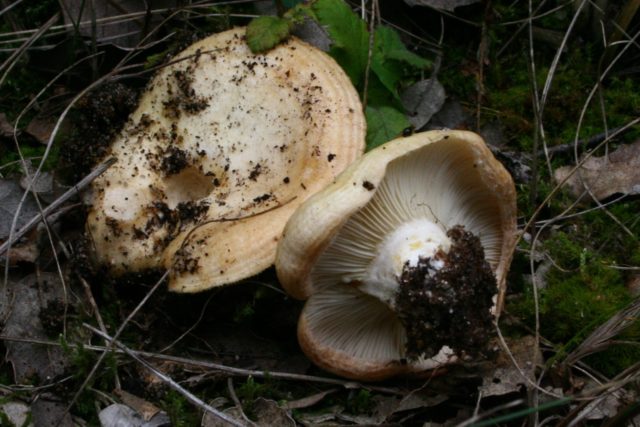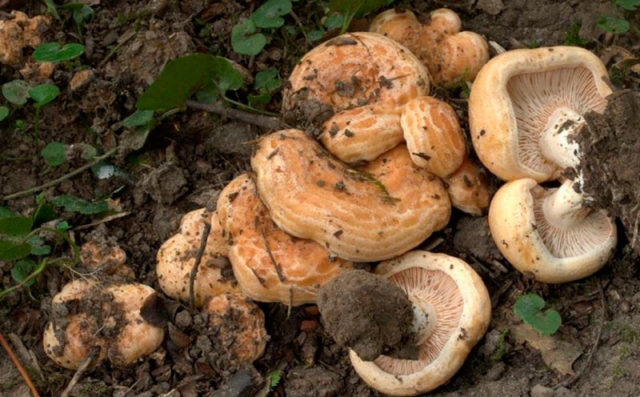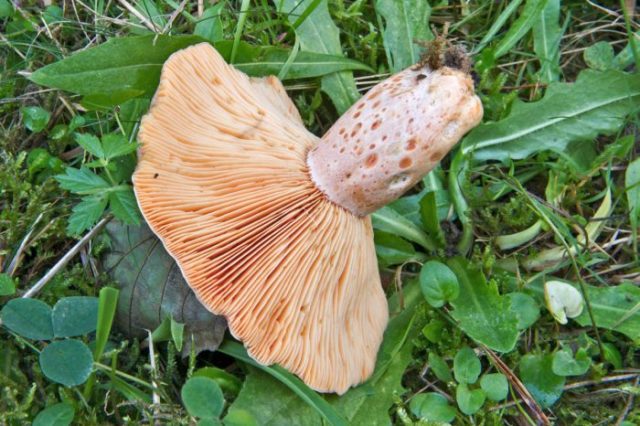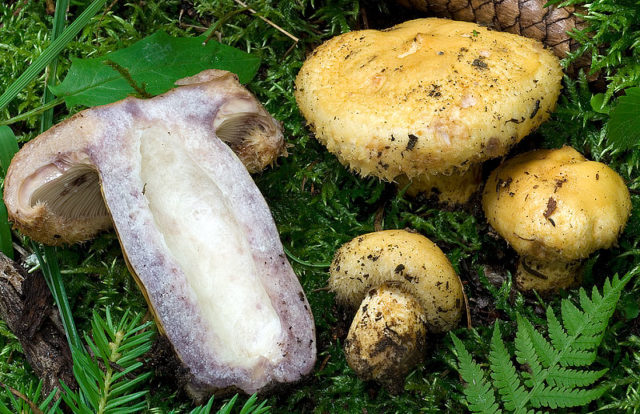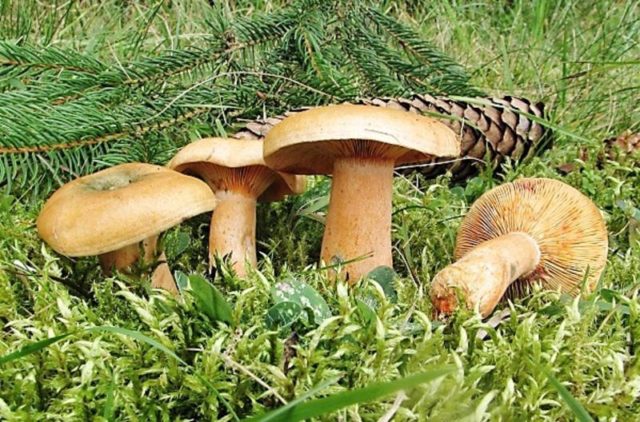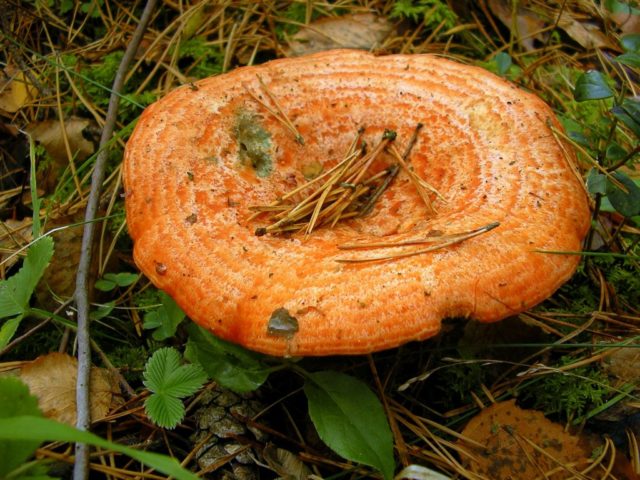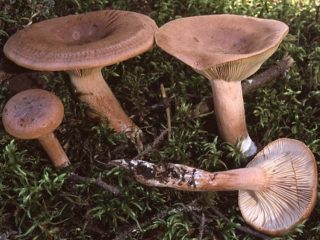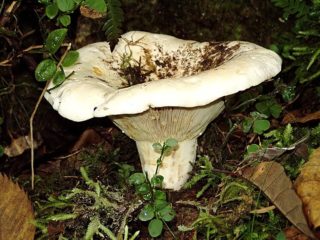Content
Oak mushroom is a mushroom from the Syroezhkovy family, which is also found in descriptions under the name of oak mushroom. The fungus has a good taste and, moreover, has a lot of useful properties, you should familiarize yourself with them in a little more detail.
Where the oak bush grows
The habitat of oak mushroom growth is broad-leaved forests, mainly oak forests, which explains the name of the fungus. The fungus is found not only under oak trees, but also under hornbeams and beeches, it comes across during the period of active fruiting quite often.
The fungus has an interesting feature, which is reflected in the name - it grows most often in large groups. Moreover, the mushrooms are located very closely to each other and more resemble a small bush or bunch.
What does an oak lump look like?
Photos and descriptions of oak camelina demonstrate that it is easy to distinguish it from other varieties by its brick-orange or yellow-orange bright cap. The shape of the cap is funnel-shaped, the felt edges are slightly curled inward. The underside of the cap at the oak breast is covered with wide, frequent blades with a reddish or white-pink color.
The oak fungus has a dense and even stalk of pink or off-white color. Inside, the leg is hollow, at the bottom it tapers slightly.
The flesh of the mushroom on the break is dense, white or pale creamy with white milky juice. A recognizable feature of oak mushroom is that its sap does not change color from contact with air.
Is it possible to eat oak milk
Oak fungus is conditionally edible. This means that it is allowed to eat it, but the fungus requires careful processing. You cannot eat raw fungi - milky juice gives them a bitter taste and special pungency.
Mushroom taste
Oak camelina is classified in the 2nd category of edible mushrooms - the taste characteristics are quite high, but they are inferior to the taste of "noble" mushrooms. Fresh oak mushrooms are very bitter and pungent, they can only be cooked after prolonged soaking - water relieves mushrooms of an unpleasant pungent taste.
Benefits and harm to the body
In cooking, the fungus is valued not only for its pleasant taste that appears after a long soaking and heat treatment. Milk is of great benefit to the body.
- The mushroom contains a huge amount of protein - 100 g of the product contains more amino acids and protein compounds than beef. Therefore, it is highly recommended to eat milk mushrooms for vegetarians and people with an increased need for protein foods.
- Oak mushrooms have a positive effect on the metabolic system, they help remove toxins from the body, lower blood cholesterol and help regulate sugar levels.
- You can use milk mushrooms for inflammatory diseases, ailments of the gallbladder and liver. The fungus effectively fights infections, and also prevents kidney and liver ailments, regulates the secretion of bile.
- Milk mushrooms contain many vitamins from the B group, so you can eat them for diseases of the muscular and nervous systems, with neuroses and problems with sleep.
- The composition of oak mushroom contains substances that are beneficial for tuberculosis and emphysema - the fungus helps to fight severe pulmonary ailments.
Eating fungi is useful for maintaining beauty and youth. They contain vitamin D, which is responsible, among other things, for cell renewal and for maintaining healthy hair and skin.
Of course, with its unconditional benefits, oak mushroom has some contraindications. It is not recommended to eat it:
- with chronic diseases of the stomach and intestines - the fungus is difficult to digest and can aggravate the condition with ulcers and gastritis;
- with allergies to mushrooms or individual components in their composition;
- with a tendency to diarrhea or chronic constipation.
False doubles
The oak mushroom does not have toxic counterparts - all mushrooms that can be confused with it are somehow suitable for food. Most often, the mushroom is confused with several varieties of saffron milk caps, and they can be eaten at all even without preliminary soaking.
Japanese redhead
This mushroom resembles an oak mushroom with its outlines, the structure of the leg and cap and its color, it is not only light pink, but also orange or reddish. On the cap of the Japanese camelina, divergent circles of salmon or terracotta color are noticeable, and the leg has a similar structure.
The easiest way to tell the mushrooms apart is to break them and look at the flesh. In the Japanese mushroom, it is not white, but a rich red milky juice that stands out.
Blue lump
Blue and oak milk mushrooms belong to the same genus, so they are easy to confuse with each other, they are similar in size, structure and color. In a bluish look, the cap is usually yellowish and brittle at the edges, and the flesh is dense and white.
However, you can recognize the false double by its characteristic feature, reflected in the name. If you press down on the leg of a blue weight, it will take on a bluish tint. At a break, the mushroom secretes a white milky sap, and from contact with air it acquires a light purple hue.
Spruce mushroom
Like the oak milk mushroom, the spruce mushroom can have a reddish color of the cap. Mushrooms are similar in shape and size. But the difference between them is that the spruce mushroom quickly turns green from contact with air - a green tint acquires pulp at a break, as well as a leg and lower plates when pressed.
Another difference is the milky juice, which in the spruce mushroom is not white, but red. The taste of raw camelina is quite pleasant, but the milk mushroom has a noticeable bitterness.
Pine mushroom
Oak milk mushrooms are often confused with common camelina, mushrooms have almost the same bright color and are very similar in structure. Despite the fact that the mushroom grows mainly under the pines, and the milk mushroom - mainly under the oak trees, sometimes the latter can also be found in coniferous forests.
However, the difference is easy to see. Pine camelina at the places of cuts turns green rapidly, its milky juice is orange and also turns green from contact with air.
Collection rules
The oak mushroom begins to ripen in July, but it is rarely possible to meet it during this period - the mushroom develops mainly underground. Only closer to autumn, oak mushrooms come to the surface en masse, and the peak falls in September and October, at which time they need to be harvested.
Look for oak mushrooms in deciduous forests with a predominance of beeches, oaks and hornbeams. Sometimes milk mushrooms come across even in pine forests.Since the collection takes place in the fall, it can be difficult to see the orange caps of the mushrooms in the fallen leaves, you need to carefully look at your feet.
In order not to harm the mycelium, it is recommended to remove the fungus from the ground by gently "unscrewing" the leg. You can also use a sharp knife to cut away the fungus above the ground. For collection, you should choose clean forests located away from major cities and major roads.
Cooking oak milk
It is impossible to eat oak mushrooms raw, they have too bitter taste and require prolonged soaking. Before cooking, peeled milk mushrooms are placed in cold water for several days, which is periodically replaced. During this time, all the milky juice comes out of the pulp, and the mushrooms become suitable for food.
Oak mushrooms cannot be dried, but all other cooking methods are suitable for them. Mushrooms are pickled and salted with garlic and spices, boiled and fried, stewed and baked in the oven. Mushrooms go well with meat and vegetable dishes, they are suitable for adding to salads and soups, and the nutritional value of dishes when using a load increases greatly.
Conclusion
Oak mushroom is a useful edible mushroom that is very often found in deciduous forests in the fall. Before use, it must be properly processed and soaked, but after that the mushroom becomes suitable for any cooking method and decorates many culinary dishes.
